#george du maurier
Text
Midnight Pals: Trilby
George du Maurier: submitted for the approval of the midnight society, i call this the tale of trilby
du Maurier: its about this girl named trilby that everyone loves
du Maurier: cuz she's just the best
du Maurier: sweet cinnamon bun too good for this world
du Maurier: let me tell you, you're gonna go gaga for trilby
du Maurier: she's so great
du Maurier: what are you gonna do when the power of trilbymania runs over you
du Maurier: trilby, she's so beautiful. just the hottest woman you've ever seen
Edward Lee: bro Lee: are we talking like [gestures to indicate huge tits]
du Maurier: oh no no no nothing sordid like that
Lee: bro
du Maurier: please! i'm british!
du Maurier: trilby is the most delicate bloom of irish womanhood and possessing the fairest traits of her sex
Lee: bro
du Maurier: by which i mean feet
Lee:
du Maurier: and by god what feet does she have
Lee:
du Maurier: trilby has the most beautiful, amazing, delectable feet
du Maurier: you just wanna eat 'em up
du Maurier: and now with the new official trilby brand iced cream, you can!
du Maurier: lovingly crafted by the finest confectioners of old europe, the trilby popsicle is a treat for young and old
du Maurier: now YOU too can feel what its like to suck on trilby's perfect toes
du Maurier: just really slurp on em
du Maurier: the trilby foot popsicle, coming soon to a friendly's near you
Lee: bro
Lee: how does it taste?
du Maurier: try one
Lee:
Lee: yeah ok
du Maurier: it won't hurt you but it might make you more powerful and muscular
du Maurier: i see you're all wearing your official brand trilby hats
du Maurier: how do you all feel about trilby now?
King: milady
Koontz: milady
Poe: milady
Barker: milady
Lovecraft: milady
du Maurier: everybody loves the new trilby-inspired trilby hat!
King: [tipping trilby] i do feel a certain joie de vivre
King: in fact
King: i feel a song coming on
King: HIT IT, BOYS!
King: A LITTLE BIT OF MONICA ON THE SIDE, A LITTLE BIT OF
du Maurier: but then trilby comes under the control of the evil svengali
du Maurier: you can recognize him by his big hook nose and that he's always carrying around big sacks of money with dollar signs on them
Lovecraft: wow this is the greatest villain of all time!
du Maurier: svengali hypnotizes trilby to force her to sing
du Maurier: to go out on stage and perform
du Maurier: with her big stinky feet
du Maurier: big stinky feet, you can see the smell lines coming off them
du Maurier: just the stinkiest
#midnight pals#the midnight society#midnight society#stephen king#clive barker#edgar allan poe#dean koontz#hp lovecraft#george du maurier#edward lee
47 notes
·
View notes
Text
Parts of a Villain
Gaston Leroux’s Erik is a chimera, constructed from the parts of other villains, literary, historical, and mythological. He seems different from every angle and yet, despite his mental instability, somehow has a coherent personality that we recognize from page to page to stage.
Here is a look at some of the villains Leroux references in his unique character. This is not a complete list, so please let me know if you have meta to add - I’m here for it!
1842 Masque of the Red Death - Edgar Allan Poe
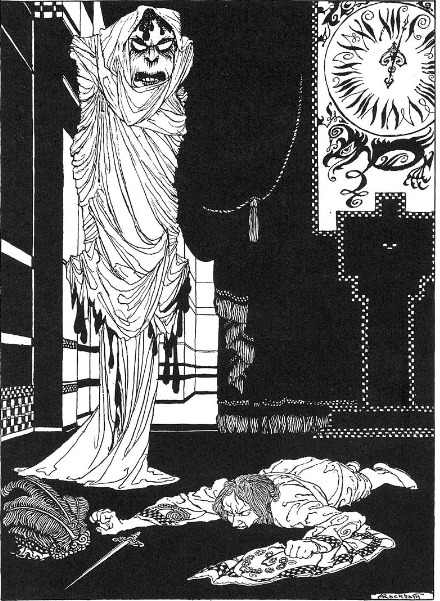
Illustration, Arthur Rackham, 1935
In the novel, Erik wears his famous Red Death costume at the Masked Ball, held at the Palais Garnier at Carnival time. In this case, it isn’t only Leroux making the literary reference - Erik himself is making a point about mortality to the other masqueraders. In Poe’s short story, the plague of the Red Death becomes personified as a masked reveler, intruding on Prince Prospero’s belief that he can literally lock death outside his party. At the end of Leroux’s novel, Erik threatens to blow up the entire Opera house, with everyone inside. Presumably, the barrels of gunpowder with which Erik planned to accomplish this are already in place beneath the Opera house during the Masked Ball. He stalks about the party dressed as a literary plague that kills everyone by the end of the story. He is a very clever corpse.
I’ve written more about these themes here: Phantom of the Opera and Carnival. Read The Masque of the Red Death for free.
1894 Trials and Executions of Anarchist Terrorists

In 1894, Gaston Leroux covered the trials and executions of three anarchists who had committed acts of terror in public spaces. A year earlier, anarchists had also bombed the Liceu Theatre in Barcelona during an opera performance. Leroux’s direct experience listening to the words of these men during their trials most likely influenced some of Erik’s more violent ideas, especially his final plan to blow up the Palais Garnier while it was at full occupancy.
I’ve written much more about Leroux’s coverage of the anarchist trials here.
1894 Trilby - George du Maurier
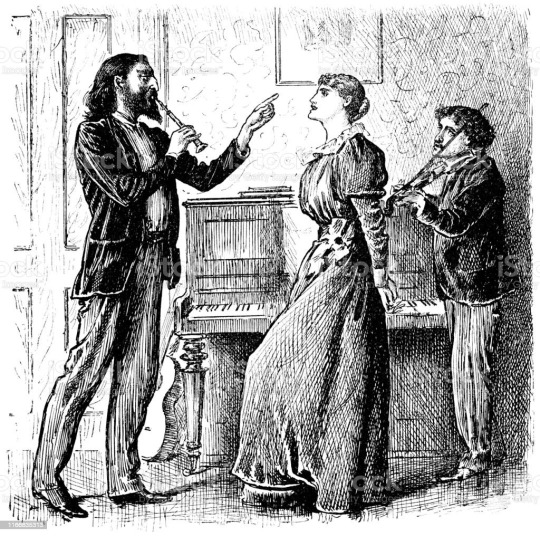
Illustration, George du Maurier, 1894
I have not read all of Trilby, but I’ll start by saying that yes, even the little I have read is just as anti-Semitic as everyone says. Svengali is a terrible caricature. It’s still relevant to point out that Leroux most likely took some inspiration from Svengali for his Erik. Svengali hypnotizes a young woman, Trilby O’Ferrall, giving her a mesmerizing voice (which she does not possess when she is not hypnotized). While Svengali does not hide in the shadows or pretend to be an Angel of Music, his influence on Trilby is similar to that of Erik’s effect on Christine Daaé, giving her career several “triumphs” while also diminishing her health and happiness. Svengali is also seen as the “other” among the novel’s characters, because he is Jewish and foreign. While Erik is born French, his many travels East also mark him as “other”.
1897 Dracula - Bram Stoker

Illustration, Edward Gorey, late 1970s
Details about Erik that indicate Leroux read and loved Dracula: the Tokay and roast chicken dinner, the coffin bed, the glowing eyes, reptilian description, the thing with the mirrors. I’ve written more about it using the tag #poto-dracula, starting with this post.
Hades & Persephone
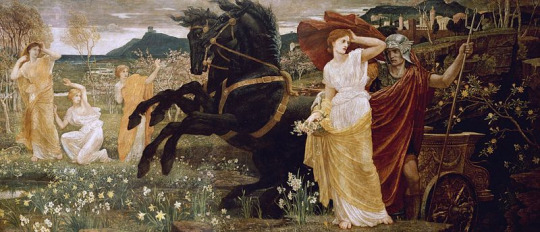
The Fate of Persephone, Walter Crane, 1877
Despite that all of Leroux’s direct references to Hades were removed from the original English translation (thanks for nothing, Tex!), most readers can still see the parallels between Erik and Hades, Christine and Persephone. Erik not only kidnaps Christine, but he lets her go, knowing that she will return. No word about whether the Opera house withers in her absence, but Raoul’s heart surely does! Beyond Hades & Persephone, Erik & Christine belong to the Death and the Maiden tradition. @thephantomessoftheopera has written a great post dissecting these themes: Eros, Thanatos and the Underworld - Death symbolism in Leroux
I know there are more references to be found in Erik’s character - let’s talk about it in the notes.
#phantom of the opera#gaston leroux#poto-dracula#dracula#masque of the red death#edgar allan poe#bram stoker#trilby#george du maurier#hades and persephone#erik x christine#dracula daily#le fantôme de l'opéra#gothic literature
302 notes
·
View notes
Text
BLOGTOBER 10/13-14/2023: THIRTEEN WOMEN, SVENGALI

I really loved this. I wonder what the book is like, I might have to read it! Author Tiffany Thayer sounds like a pretty interesting guy as per this collection of provocative reviews on Wikipedia:

I don't know about you, but that makes me want to read everything he wrote. THIRTEEN WOMEN concerns a circle of grownup sorority sisters who are beset by an anomalous series of murders and suicides. It so happens that all of the women recently received damning horoscopes in the mail from a self-styled New York Swami--but the Swami himself is just a pawn in a greater conspiracy masterminded by Ursula Georgi (Myrna Loy). The master hypnotist has a bone to pick with these smug society ladies, which I am about to spoil so plug your ears if you'd rather watch the movie first (and you should! It's only an hour long): As a half-Javanese girl "saved" by a missionary who sent her to a western finishing school, Ursula believed the key to her future was to pass for white. Therefore, she's vowed revenge on the racist sorority that rejected her in college, and honestly the revenge she has plotted should have earned her an honorary PhD. It's hard to imagine that either a 1930 novel or a 1932 movie really mean to say "fuck racism" so frankly, but the sharp premise and Myrna Loy's incredible charisma make it hard not to side with the ostensible villain in this picture.

Some people have remarked that THIRTEEN WOMEN is an early iteration of the slasher movie, with its female ensemble (of sorority babes no less) being picked off one by one. To me it was more reminiscent of the cursed media motif familiar to J-horror. Maybe I'm just saying this because I rewatched RINGU this Blogtober and I was encouraged by the documentarians behind THE J-HORROR VIRUS to consider its influence on SMILE, which I also rewatched, and which I'm realizing I love. The victims in THIRTEEN WOMEN have signed a round robin chain letter, for which they each receive a star chart describing their imminent doom; the power of suggestion takes the place of power tools here, with Ursula's sheer force of will acting as a free-floating contagion that rots the guilty and weak from the inside out. I was reminded of movies like RINGU and JU-ON as much as of Jorg Buttgereit's DER TODESKING, an experimental horror film about a chain letter that causes its recipients to self-destruct. It's fun to think that THIRTEEN WOMEN is a progenitor of movies like BLACK CHRISTMAS, but I see reflections of it elsewhere, too.

I wound up pairing this with SVENGALI just because they're both hypnosis movies, but that movie turned out to have its own racial tensions. In George du Maurier's foundational 1894 novel Trilby, the evil hypnotist is explicitly Jewish; in Archie Mayo's 1931 adaptation, Svengali is referred to abstractly as "Polish or something", which seems to be a euphemism for a Semitic Eastern European identity. This might not invite such analysis if it weren't for the styling of John Barrymore as a swarthy, rodent-like embodiment of greed. When I say that, it sounds pretty negative, but I'd still insist that SVENGALI is a great movie well worth seeing for its perverse humor, surprising grimness, expressionistic design (courtesy Anton Grot), and unusual horror elements--in addition to Barrymore's unforgettable performance.

I guess there has been some debate over whether SVENGALI is properly a horror movie, and I refer you to author Tony Burgess who once said that if you have to argue about whether or not something is a horror movie, then it's probably a horror movie. The only causes to argue are if you insist on an extremely narrow definition of horror to guide your personal consumer habits, or if you're squeamish about admitting that you've ever enjoyed or respected anything that falls under the horror umbrella (and I tend to think the latter case is more prevalent). Admittedly, SVENGALI blends comedy, romance, and musical elements such that the viewer is never quite sure how dark things will get until the very end, but I think that anyone should be able to see the horror in the incredible sequence of the eponymous villain sending his disembodied consciousness through the CALIGARI-like city to possess the unwitting Trilby (played by Marian Marsh who must have been the most adorable person alive at the time). A few different visual effects are used to evoke Svengali's power, some of which are still modern-looking and scary, and the film's breezy humor and charm do not promise any particular safety.

On some level, the aura of antisemitism and xenophobia itself lets us know we're in horrific territory. This is the genre of fears, rational and irrational, where we face whatever society perceives as threatening. Today we're in the midst of a lot of arguments about whether or not "separating the art from the artist" is ever appropriate, with full cancellation of the art AND artist positioned as the only alternative, but both of these options suggest that we must never have to face immorality, ambiguity, or ambivalence in art at all; we're forced to either avoid it or ignore it. This denies us the opportunity to understand what these darker emotions consist of, and understanding is the only way to defang them. Personally, I don't think it's any more helpful to condemn e.g. Dracula or the Wicked Witch of the West for their bigoted elements, than it is to simply pretend those things aren't there at all. SVENGALI provides us with a similar opportunity to confront antisocial phobias, with its troublingly caricaturesque villain and the unavoidable fascination one feels when his hypnotic gaze projects itself at us from the screen. Recommended viewing.

#blogtober#2023#horror#thriller#slasher#adaptation#racism#thirteen women#george archainbaud#tiffany thayer#myrna loy#svengali#trilby#george du maurier#archie mayo#john barrymore#marian marsh#pre-code#anton grot
18 notes
·
View notes
Note
Do you know of any other similar gothic stories from the same time period as Dracula?
If you want a much wilder and much more racist ride than Dracula, it was published the same year as Richard Marsh's The Beetle, a gothic novel which also features a very sad initial narrator, a hyper-competent heroine, and a marauding foreign menace. It should be noted, however, that the very rough equivalent of Jack Seward is just a blatant supervillain who nobody notices is a supervillain. Instead of "She doesn't love me so I did some questionable psychiatry :'(", he's "She doesn't love me so I'll turn my thoughts to my unstoppable death gas >:("
You should also definitely check out Carmilla (1872) if you haven't, as it's an earlier vampire story that obviously had some influence on Dracula. While I cannot, in good faith, recommend Trilby without warning that it is overtly and unapologetically antisemitic to the point of being difficult to read (I would not read it again were I not doing scholarship that touches on it), it definitely has a mesmeric villain who may have influenced Dracula and it might be of interest to people interested in tracing mesmeric fiction or looking to literary precursors of The Phantom of the Opera.
Beyond that, I greatly enjoy almost all the hit fiction of the late Victorian gothic revival (Strange Case of Dr. Jekyll and Mr. Hyde, The Picture of Dorian Grey, The Great God Pan), but I'm not sure there's anything off the top of my head that strikes me as being particularly Draculaesque in particular beyond what's listed above. If you're interested in tipping into the 20th century, Stoker would later go on to write a mummy novel (The Jewel of Seven Stars) that uses a lot of the same tropes and character types as Dracula (the hero, like many of the heroes of his novels, is a hot young lawyer). Jewel isn't nearly as good as Dracula though in my opinion.
#Bram Stoker#Dracula#Dracula Daily#J. S. LeFanu#Carmilla#Richard Marsh#The Beetle#George Du Maurier#Trilby#The Jewel of Seven Stars#Dracula Daily asks
211 notes
·
View notes
Text

#vintage magazine#illustration#printmaking#library of congress#george du maurier#the monthly illustrator
8 notes
·
View notes
Text
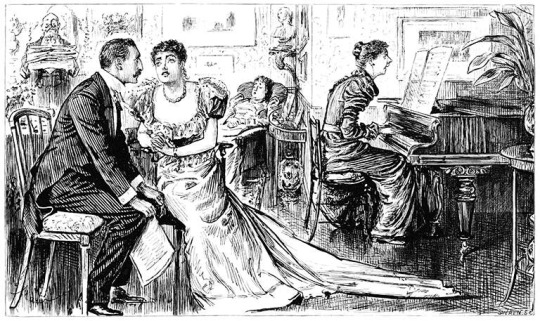
George Du Maurier (Franco-British, 1834-1896) • Illustration for Punch Magazine • c. 1889
#illustration#art#illustrator#artwork#george du maurier#magazine illustration#punch magazine#british illustrator#sassafras and moonshine blog#illustration art#british magazine
4 notes
·
View notes
Text
Sure hope there won't be "Trilby Weekly". Because the one rape narrative I absolutely refuse to take seriously, is the one where a goy girl got brainwashed by her evil Jewish hypnodaddy. Anyway, if there're any Jewish hypnodaddies in the audience, I'm wishing you best of everything, hope your subs are bomb and their tongue game is strong.
6 notes
·
View notes
Photo

A poster for the book ‘English Society’ (1897) by novel writer and cartoonist George du Maurier (1834-1898). The book of that title by the author appears to be a collection of drawings by du Maurier, probably the cartoons he had drawn for ‘Punch’ magazine 1865-1891 although he worked as an illustrator for five magazines outside of his work for ‘Punch’. This poster was designed by American poster designer Edward Penfield (1866-1925) who resided as a major artist in ‘the golden age of illustration’ in America, which was surely a golden age of writing for periodicals too.
3 notes
·
View notes
Text
“Language is a poor thing. You fill your lungs with wind and shake a little slit in your throat, and make mouths, and that shakes the air; and the air shakes a pair of little drums in my head—a very complicated arrangement, with lots of bones behind—and my brain seizes your meaning in the rough. What a roundabout way, and what a waste of time.”
― George du Maurier
0 notes
Text

The Living Dead (The Scotland Yard Mystery, 1934) R-1936 - Trade ad
#the scotland yard mystery#the living dead#gerard du maurier#grete natzler#george curzon#1934#1930s movies#thomas bentley#crime#mystery#trade
27 notes
·
View notes
Text

George L. Du Maurier - Trilby hypnotised by Svengali, illustration from ''Trilby''.
#George L. Du Maurier#Trilby hypnotised by Svengali#Trilby#hypnotised#hypnotism#Svengali#mesmerism#magician
6 notes
·
View notes
Text
About tragic backstories. About mourning.

Available on AO3!
(ch.I / VI)
Who Killed Markiplier? Rebecca (by Daphne du Maurier)!AU, with a bit of a Gatsby twist, sprinkled with notes of Mike Flanagan's work (The Haunting of Hill House/Bly Manor).
fandom: Markiplier - Who Killed Markiplier?
chapter wordcount: 4967
quote from the chapter:
Only blurry images of Mr. Iplier’s face could be captured. All the falling scarlet petals and all the intertwining poison-green branches and all the pointed thorns of the rosebush protected him from the camera; already in his lifetime, he was one of the most difficult subjects for the paparazzi who sought to defame him, and even after his death: no one seemed to be able to take a scandalous picture of him.
notes: And the really grisly stuff is just beginning.
taglist: (this is a new thing, we'll try it out! if you're interested in tumblr-notifications on further chapters, write under this post or dm me!)
@mindemenyedelmem @ukulillii @zuliplier @selfshippinglover
#markiplier#who killed markiplier#wkm#actor mark#celine the seer#damien the mayor#william j barnum#william the colonel#benjamin the butler#abe the detective#george the groundskeeper#the markiplier manor#alternate universe#rebecca daphne du maurier#fanfiction#ao3#we're not meant for happiness#chapter 1#angst#my works
19 notes
·
View notes
Text
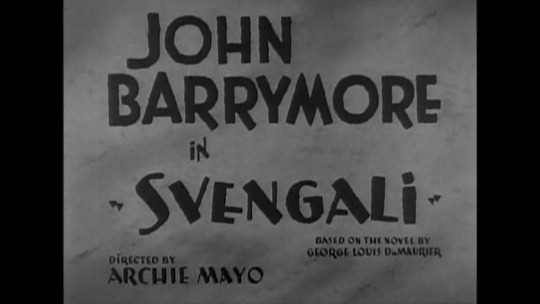
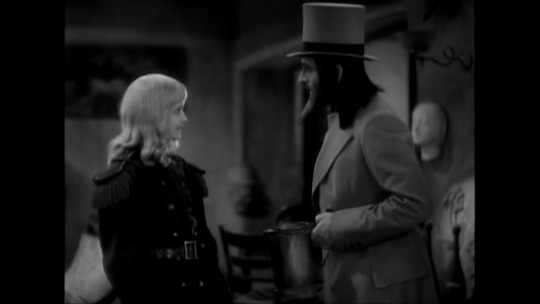
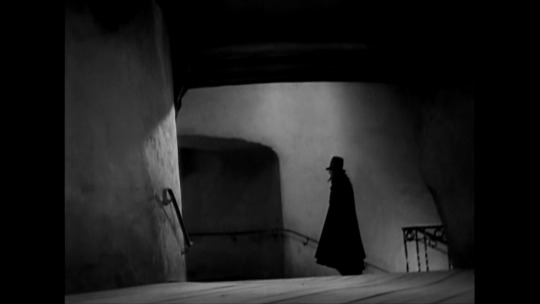

youtube
Svengali (1931)
My rating: 4/10
Them dang dirty foreigners with their weird Romanian/Russian/German accents and their looking like a mix of Rasputin and an offensive Jewish stereotype and their evil rapey mind control, amirite? I mean, boy has this one aged poorly.
#Svengali#Archie Mayo#George L. Du Maurier#J. Grubb Alexander#John Barrymore#Marian Marsh#Donald Crisp#Youtube
1 note
·
View note
Text
Rebecca (PG): Classic Hitchcock, but heavy on 40's mysogeny.
#onemannsmovies review of "Rebecca" (1940). The Hitchcock classic doesn't fare well wrt sexism, but its still a fabulous movie. 4.5/5.
A One Mann’s Movies review of “Rebecca” (1940).
The photo above for “Rebecca” comes from the special poster produced for the film by Harbour Lights cinema in Southampton (a splendid little cinema!). Harbour Lights staff, in this case Anastasia, get their personal film favourites shown again on the big screen. And what a joy it was to see again this Hitchcock classic – an Oscar “Best Picture”…

View On WordPress
#Alfred Hitchcock#Armie Hammer#BAFTA#bob-the-movie-man#Cinema#Daphne Du Maurier#Film#film review#George Barnes#George Sanders#Joan Fontaine#Joan Harrison#Judith Anderson#Kristin Scott Thomas#Laurence Olivier#Lily James#Movie#Movie Review#Nigel Bruce#One Man&039;s Movies#One Mann&039;s Movies#onemannsmovies#onemansmovies#Rebecca#Reginald Denny#Robert E. Sherwood
2 notes
·
View notes
Text
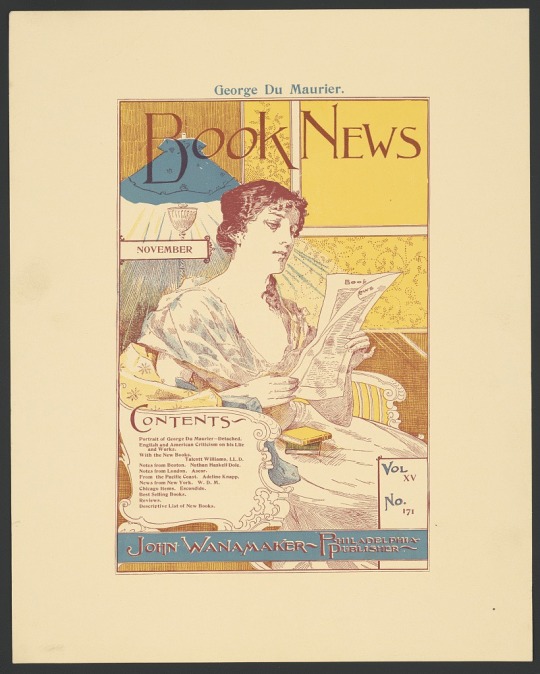
3 notes
·
View notes
Text
Winding Up the Week #327
An end of week recap
“It was a bright cold day in April, and the clocks were striking thirteen.”
– George Orwell
You could have knocked me down with Vladimir Aniskin’s Levsha when I learned that one of my favourite online booksellers, Book Depository, is closing later this month. Not only is this dispiriting news for its long-standing customer base from over 170 countries, but it also creates a…

View On WordPress
#1940Club#1940 Club#Book Depository#Books#Daphne Du Maurier Reading Week#Easter#George Orwell#Reading
1 note
·
View note